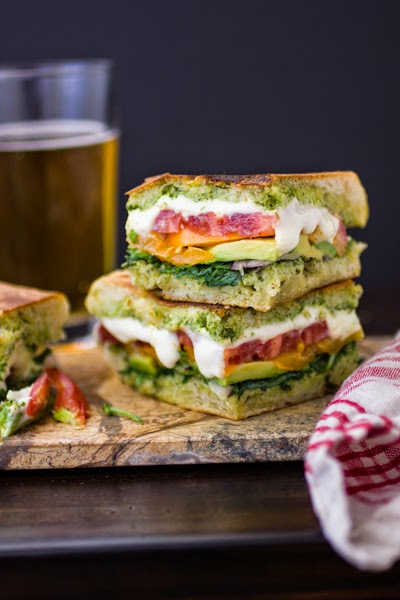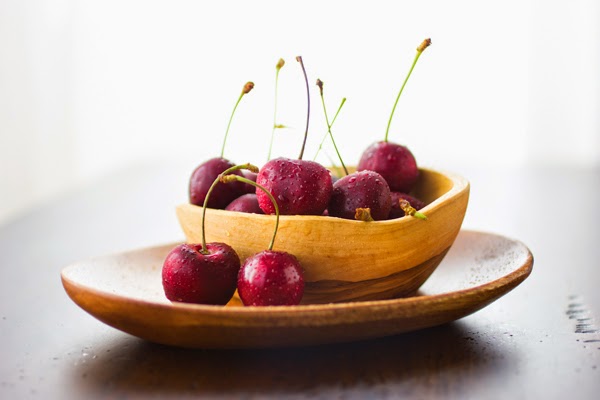When I cook at home, I use nearly 100% seasonal, organic and locally-grown ingredients. I don't want to get all preachy, but it seems like a no-brainer to eat food that tastes better and has the lowest impact on the planet. So what if it's more expensive? You get more nutrients and fewer harmful pesticides. And, to quote an old hair commercial, You're worth it.
 |
| Farro Cucumber Salad |
Below is an ever-evolving list of ingredients I enjoy working with, including my favorite sources in the San Francisco Bay Area.
Produce
If I didn't have an amazing co-op at my fingertips that carries such exotic stuff as fresh lemon verbena, turmeric root, squash blossoms and padron peppers, I would spend a lot more time at the Bay Area's farmer's markets. Produce tastes best when it's grown close by, picked when ripe and eaten fresh. Farmers markets and enlightened co-ops will usually let you taste before you buy; this is a great way to get to know what's in season when. Receiving a weekly produce box from a local farm (called Community Supported Agriculture, or CSA) is another. Terra Firma, Eatwell, and Riverdog all deliver to the San Francisco Bay Area and have beautiful produce (and sometimes flours, eggs, and other goodies). Frog Hollow has an all fruit CSA that is to die for. But perhaps my favorite place to pick up produce is Everett Family Farm near Santa Cruz, where you weigh your own produce on the honor system and stick your money in a box.
 |
| Super-Moist Pink Pearl Apple Cake |
Dairy
I love Strauss dairy, which is produced here in Northern California. Their milk and cream is minimally processed (not ultra-pasteurized), and it tastes so sweet and fresh that I often can't resist swigging it straight from the glass bottle. I'm thrilled that they've recently come out with a line of greek yogurt, which tastes rich and creamy with a mild tang. Their ice cream is excellent, as well.
 |
| Topping for Plum Rhubarb and Raspberry Cardamom Crisp |
Butter
I always use Strauss European-style unsalted butter, which is 85% butterfat (as opposed to commercial butters which have less fat and more water). Pie doughs, scones, pound cakes and cookies will all taste more rich and flavorful when made with excellent butter. Butter from cows that get to graze on grass and flowers will also be richer in color. (I even read about some sheep who graze in a violet field and produce lavender colored milk!)
Eggs
Eggs in my recipes are always "large" (2 ounces by weight) unless otherwise specified. For baking, I tend to use organic Clover or Glaum eggs, both produced locally. For dishes where the eggs are the main focus, like Shakshouka, I splurge on eggs from Eatwell Farm (which you can get through their CSA and at Rainbow Grocery), which have the brightest yolks and come in varying colors and sizes. Even most "free-range" chickens have had their beaks clipped, and this prevents them from pecking at bugs and getting as rich a diet as those without clipped beaks. Plus it's just sad. Farmer's markets (and increasingly, health-food stores) will often carry these eggs from happy chickens. Once you get over the sticker shock, you'll be pleasantly surprised at the high quality of these eggs, such as the one shown above, and you'll reap the benefits in the form of more nutrients and a more pleasurable "eggs-perience." (Sorry.) If you are dedicated enough to keep your own chickens, I applaud you!
Sweeteners
At any given time, my pantry contains organic granulated, light brown, dark brown, and powdered sugars from Wholesome Sweeteners; maple syrup and maple sugar; agave nectar; honey; dark molasses; non-GMO corn syrup; brown rice syrup; Alter Eco's unrefined muscobado sugar; and coconut sugar. The sweeteners serve different purposes, and I play with them all in my baking. Agave dissolves nicely into drinks such as the Indian Summer Blues with Cardamom, Rose and Gin. Honey is delicious in Masala Chai and Black Sesame Granola. ANZAC Biscuits wouldn't be authentic sans Lyle's Golden Syrup. Molasses is necessary for spice cookies and Cranberry Pear Upside-Down Gingerbread, and what would a stack of Banana Buckwheat or Ricotta Pancakes be without a pour of maple syrup?
Flours and grains
Grains not only contain different nutrients, they also have unique flavors and baking properties. Glutenous grains include wheat, spelt, barley, rye and kamut. Some gluten-free grains are oats, buckwheat, rice, corn, amaranth, millet, and quinoa. I love experimenting with different flours, whether I'm baking gluten-free or not. A few excellent cookbooks that explore a range of grains and flours are Good the the Grain, Pure Dessert, and Super Natural Cooking. Some favorite alternate grain recipes on this site include Buckwheat Chocolate Chip Cookies, Kamut Flour Pizza Dough (with asparagus and pesto or otherwise), Oatmeal Molasses Bread, and Plum and Barley Flour Biercake.
 |
| Apple Quince Tart with Gluten-Free Buckwheat Crust |
Gluten-free grains
When I bake gluten-free, I primarily turn to oat and millet flours, whose warm, earthy flavors enhance a variety of baked goods, and sweet white rice flour, which is neutral-tasting and similar to all-purpose wheat flour. Sweet white rice flour, available here, is not interchangeable with regular brown or white rice flour, so if you find yourself without it, you'll want to add xanthan gum to the recipe (usually 1/2 teaspoon per cup of flour). I haven't explored the gluten-free blends out there, as they tend to cost more than making my own combo, and they often contain bean flours which taste unpleasant to me. Oat and sticky rice flours, with the occasional tapioca and xanthan gum, tend to do the trick. Some favorite gluten-free recipes include Bittersweet Whiskey Brownies, Nectarine Plum Almond Upside-Down Cake, Über Chocolate Cookies. For a full listing, see the Recipes page under Gluten-Free.
 |
| Chocolate Almond Olive Oil Cake |
Oils
When I cook with high heat, extra-virgin coconut oil is my pick. Coconut oil also makes a good substitute for butter in many baked goods as, like butter, it is solid at room temperature, and its nutty-sweet flavor enhances many sweets, such as Vegan and Gluten-Free Hippy Crispies. Ghee, or clarified butter, has an even higher smoke point, and is ideal for very high heat cooking, such as making popcorn (or Bourbon Cacao Nib Caramel Corn, for that matter). For lower-heat cooking and baking, I use light, extra-virgin olive oil and sunflower oil. Toasted sesame oil is essential for finishing certain Asian dishes, like Spring Vegetable Fried Rice, and super-good olive oil completes simple dishes like Melon with Feta, Lime and Mint, and some baked goods, like Tangerine Olive Oil Pound Cake.
 |
| Tarragon Olive Oil Ice Cream, with Malden salt |
Salt, Spice and Everything Nice
I use two types of salt: fine sea salt for cooking and baking, and Malden salt for finishing dishes. Malden salt's crystals are large, flaky pyramids, and a pinch crumbled over a salad or sauteed padron peppers adds a flavorful crunch. But sweets can benefit from a sprinkle of flaky salt, too, such as Chocolate Caramel Macadamia Nut Bars and Butterscotch Pudding.
When it comes to spices, fresh is best. If you don't know how old the spices in your spice rack are, throw them out and get some new ones. Some spices have especially volatile oils that diminish in flavor quickly. These are best bought whole, and ground as needed, like nutmeg, black pepper, cumin, coriander and cardamom. In addition to the usual sweet baking spices (cinnamon, allspice, cloves, ginger and nutmeg), I often reach for smoked paprika, curry powder, and turmeric.
 |
| Pan Bagnat with Basil Vinaigrette |
I always use fresh herbs when possible, but occasionally add dried oregano or thyme to a sauce or soup. Don't bother with dried soft herbs like basil, chives or tarragon; their flavor doesn't preserve well dried.
 |
| Dreamy Vanilla Ice Cream + Peach Crisp |
Vanilla beans make appearances in many of my recipes. Don't buy the über-pricey beans in the super-market; order them in bulk, or, if you live in the Bay Area, pick up a bunch at Vanilla-Saffron in the Mission. I rinse and dry used beans and stick them in a mason jar covered with whatever neutral-tasting alcohol I have on hand (vodka, white rum or brandy) to make my own vanilla extract.
 |
| Salty Double-Rye Chocolate Chip Cookies |
Chocolate
Favorite brands for baking include Scharffen Berger, Guittard, Valrhona, and Dagoba. I usually bake with bittersweet chocolate with a cacao mass of 70%, but there are some excellent dark milk chocolates and vanilla-flecked white chocolates out there, including Green and Black's. Cacao nibs (broken up chocolate beans) make an excellent addition to cookies and other treats. I usually use dutch-processed cocoa powder, as I like its old-fashioned flavor (think Oreos). A favorite application for it is this Chocolate Bourbon Banana Cream Pie.
 |
| Rosemary Peach Maple Leaf |
Spirits
Wine, beer and spirits often find their way into my cooking. When I'm not mixing up Sweet Cherry Manhattans, I'm often adding bourbon to Pecan Pie, Rum to Banana Cakes, and beer to cheesy Gougères.
A note about recipes
I often give amounts in ounces as well as cups; ounces are always by weight, unless otherwise specified (such as in cocktail recipes). For folks outside the US, this is a great site for converting measurements into grams.









